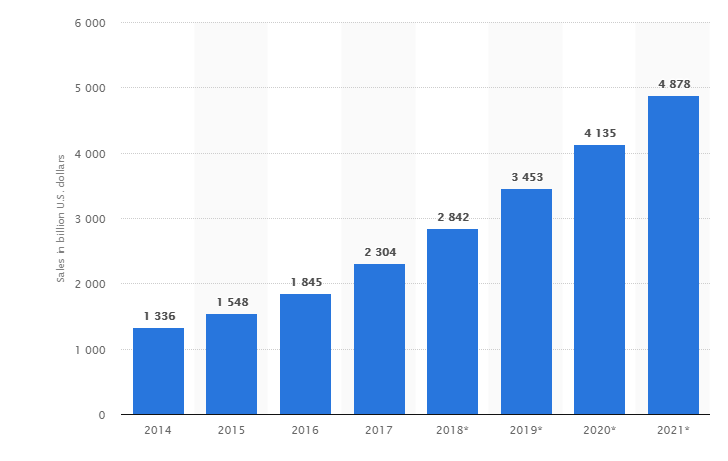Over the last ten years, eCommerce has seen unprecedented growth across the world. People belonging to all age groups – be it, children, millennials or the older mass, the majority prefer shopping online over physically buying in-store. According to the survey done by The Next Scoop, retail eCommerce sales ratio from 2014 to 2024 will rise around 200%. In such scenarios, retailers across the world are migrating to eCommerce because of greater sales and loyal online customer bases.
Here’s a detailed look at eCommerce development and trend of online shopping amongst the masses
eCommerce VS Traditional Stores: Who Does it Better?
With every shopping experience, the supplier and the client get deeper into the global market, establishing a relationship without investing tons of money. Traditional marketing is based on word of mouth, there are several limitations which exist in its principles, which eCommerce comfortably beats in the following aspects:
● Reduced Costs:
Physical store owners have to cough up regular costs for setting up, maintenance, warehousing and other essentialities in brick and mortar store. Even after fixed investment, there’s no absolute revenue generation assurance from their shops. On the other hand, online stores come with flexible solutions that attract customers using offers, promotions, digital marketing campaigns etc.
● Access to Worldwide Market:
Global boundaries are easier traversed with eCommerce while physical stores might take several years to build into a successful franchise that features stores across the world. The potential of global sales is one of the most significant reasons for modern retailers to prefer selling online rather than in traditional ways and makes global ambitions a lot easier to envision.
● 24X7 Unrestricted Customer Sales:
While physical stores run for 8-10 hours a day with available store staff to assist customers, online stores can run every minute of the day and thus increase their potential orders.
● Personalized Shopping Experience
With developments in Data Science and AI, customers can now have completely customized shopping sprees based on their previous views of an eCommerce store. Further, eCommerce portals can access and reach out to numerous people by featuring advertisements on social media and search engines. Both former and latter options work together for customers (and leads) to provide a rich purchase experience. Physical stores are limited to numbers of customers, in general, and would require several upgrades to reach more customers within their proximity.
● Access to the Sales Improving Apps
While eCommerce is all about helping users to shop in an easy and more comfortable way, many online platforms have tons of apps which also helps shopkeepers to improve their sales. One of the trendy apps is Tada. It is a unique solution for the business owners who runs online stores on Shopify. It helps owners to create gamified popups to collect more subscribers while keeping users engaged in games. One of the best ways to provide the users with a funny shopping experience, right?
The Scope of the eCommerce Market in 2019 and Beyond

The uphill journey of eCommerce has been both scary and exciting since its inception. According to Statista, global eCommerce retail sales are to reach $4.9 trillion by 2024, this would mark a 265% growth rate – from $1.3 trillion in 2014 to $4.9 trillion in 2024.
According to reports, by 2024 there will be 230.5 million online customers – in which the majority would be women. Brandongaille says that millennials currently within the age group of 18-34, spend more than $2,000 online every year on shopping. From the above, it is evident that the demand for online shopping shall grow exponentially in coming years.
How Magento Fits Right Into Your eCommerce Business
Online eCommerce stores that lack functionality and features are more vulnerable to losses even with proper management. With the right platform, themes, plugins and tools, you can easily manage as well as yield more from your eStore. While there are several tools and platforms available in the market to make your business processes run hassle-free, Magento design development is known for its high-end functionality that has managed several industry leaders like Coke, Burger King and Nike to name a few.
Why Are Industry Leaders Choosing Magento?
Greenwing Technology’s punchout connector is compatible with the latest Magento 2 versions, including 2.3 and 2.4. This connector seamlessly integrates Magento eCommerce systems with ERP or eProcurement systems, acting as a bridge between the user login and the transfer of the shopping cart back to the procurement system. This integration facilitates seamless communication between systems, offering a streamlined and efficient process
The Content Management System (CMS) provided by Magento is dynamic and can be automated according to your current business needs. Such liberty makes Magento tick amongst most business owners for its explicit functionalities, compelling marketing, search engine optimization and catalog-management tools. These tools can help you almost glide through the otherwise intricately detailed works of catalogue management, shopping cart integration, shipping discounts, etc; I will elaborate on these later in the article.
Without going too deep into details, here are the three main versions of Magento that you can choose from:
● Magento Open Source: Alright, so this version of Magento is used by the majority of Magento users – because it’s FREE! This community delivers a lot of great features and is built specifically to suit the needs of eCommerce business owners in general.
● Magento Commerce: This version is a hosted solution and is similar to an offering provided by that of Shopify. Small retailers prefer Magento Commerce.
● Magento Enterprise: Welcome to the premium version of Magento! It’s a chest of unlimited functionality which can help enterprise level companies add more value to their business. However, this version is strikingly expensive to the previous ones and is best suited for mid-level retailers (or larger) who can take full advantage of the flexibility it provides.

Breaking Down Magento: How Does it Work?
As I mentioned earlier, no eCommerce store can thrive without multiple functionalities and features. With the right extensions, you can track various orders, manage several products, add numerous payment gateways and much more. Magento is known for its flexibility and customization potential, whilst requiring a bit more maintenance than more restrictive ecommerce platforms. To derive the most benefit, it’s recommended to employ a dedicated Magento developer.
Here’s a checklist of eCommerce business essentials:
● Online Marketing, Promotions and Conversion
To get your eStore noticed among others, there are several ways in which you can multiply your traffic and establish your customer base online. Here’s a detailed list of services:
● Creation of product categories
● Multi-tier prices for bulk discounts
● Related products suggestions, up-sells and cross-sells
● Discounts restricted to stores, customer groups, time periods and products
● Using discount or coupon codes
● Newsletter management
● Free shipping options
● A persistent shopping cart
● Wishlist reminders on emailers
Boosting Search Engine Optimization (SEO)
All aspects of your website should be SEO optimized. The better your SEO practice, the higher you’ll rank in Google SERPs (search engine result pages). SEO is the lifeblood of your eStore and will allow you to generate maximum organic traffic, engagement and leads. A few places to begin SEO optimization are:
● Implementing a Google Site Map
● Search Engine Friendly URLs
● URL rewrites to have full authority of URLs
● Meta-information for products, categories and all content pages
● Auto-generated site map for onsite display
● Auto-generated accessible search terms page

Effective Site Management
Site management is the direction you require to achieve successful eCommerce development. Involving the following features
● Controlling multiple websites and stores from a single administration panel
● Set permissions for managers
● 100% personalized design using templates
● Multilingual and multi-currency support
● Various import and export catalogs
● CMS for landing pages and blog creation
● Pre-defined tax rates as per the location, product type or customer group
● Adding CAPTCHA to shield the store from spammers
Lucid Catalog Management
This is the section where your admin can manage every little detail concerning categories and products, this is all done from your Administration Panel. Catalog management is entirely focused on curating and updating product information. However, it needs the following features to create a comprehensive product base:
● Search and sort to navigate categories efficiently
● Category and sub-category management
● Feature categories on the homepage or during navigation
● Set category status (active/inactive)
● Set page URLs and SEO elements for categories
● Thumbnail and image management
● Secure Payment, Checkout and Shipping Options:
According to a study by Neil Patel Digital, there was an improvement of up to 5% in overall conversion rates when necessary UX fixes provide customers with a seamless shopping experience. Keeping this in mind, Magento has some unique functionalities to make sure your customers not only love your products but are also emotionally invested enough to complete the purchase process:
● Single page checkout
● Guest checkout and checkout options for customer accounts to use their address book
● Multiple address shipping within a single order
● Saved shopping cart
● Shopping cart integration with tax and shipping estimates
● Offline credit card processing
● Shipping integration with label printing – including major carriers
● Flat rate shipping per order or item
● Free shipping options
● Table rates for weight, sub-total, destination and product amounts
● Onsite order tracking within customer accounts
Managing Orders
For a complete and functional eCommerce portal, you should control all necessary viewings, editings, creation and order fulfilment from the Administration Panel. An order management system provides all the required details for simplified order management. This includes keeping addresses, sent invoices and shipment data in one place. Here are the necessary functionalities an order management system needs:
● The ability to create single/multiple invoices, shipments and credit memos as per orders, whilst allowing respective split fulfilment
● Printing invoices, packing slips and shipping labels
● Order tracking
● Efficient re-orders creation
● Email notifications of orders placed
● RSS feed for new orders

Creation of Customer Accounts
Customer accounts are a way for leads to gain a better user experience and enjoy exclusive benefits. Not only does it help gather and organize data for your business, but it means that they don’t have to waste any more time filling out forms to make a purchase, less bounces! Basic customer accounts should contain:
● Saved address book, with the ability to hold multiple address entries
● Wishlist with comment adding features
● Order status and history
● Simple reorder process
● Recently ordered and viewed products
● Default billing and shipping information
● Newsletter subscription management
● Product reviews submitted
● Downloadable products
Effective Customer Service
Customer services for any eCommerce portal holds a lot of value for a business owner. Using customer feedback data to enable a business to track every movement, updates and more. Once that is done right, engagement and organic reach go higher. Here’s a detailed list of the functionalities:
● Display Contact Us Form
● Creation and order editing from the admin panel
● Order history with status updates
● Order tracking from accounts
● Quick password reset capabilities and notifications
● Emailers about order and account updates
● Personalized transaction emailers
24X7 Global Support
If you are planning or have multiple stores that have several products for different countries and is friendly to individual currencies and languages, then it’s important
to execute the following features:
● Localization, multiple currencies and tax rates Support to customers
● Customer Support for accented characters and right-to-left text

Daily Reporting and Analysis
It is crucial for every eStore owner to have a daily or weekly analysis run on sales progression or reduction. Integration analytics help generate detailed reports for you to review and make meaningful decisions going forward. Reporting and analytics involves:
● Google Analytics Integration
● Sales Generation Report
● Low stock and stock refills report
● Products left in the shopping cart Report
● Best viewed Products report
● Best Bought Products report
● Coupons Used Report
● Search terms report
● Product reviews report
● Tax Report
● Tags report
● Sales Invoice Report
● Sales Refund Report
Conclusion
Phew! That was all about getting started with eCommerce correctly.
For getting the most out of its functionality, the obvious choice would be choosing a Magento development company for your business to execute eCommerce projects properly. While I was on a headhunt here myself, I stumbled upon custom Magento development delivered by CodeClouds.
Overall, it can be said that Magento is the place where you get the most done for the least. As the Hosting Tribunal reports that the retailers who use Magento tend to grow 3X faster than others on an average, it is evident to say that this giant platform isn’t going anywhere, anytime soon!
 Hi Boox Popular Magazine 2024
Hi Boox Popular Magazine 2024



